Markings on tires, what does all this multitude of numbers and letters mean? This question was asked by everyone who at least once bought new tires. We have already written about the choice of summer and winter tires, and now we understand in detail what the numbers on the tires of the car mean, why they are needed, and how to read this marking.
How to know the seasonality of the tire
The most reliable option is to check the tire manufacturer’s catalog. But you can also just look carefully on its sidewall for the corresponding icon or inscription. The marking of winter tires is regulated and represents a snowflake on the background of three mountain peaks. Summer tires do not have a uniform marking. They can be molded flowers, raindrops, etc. The designations M+S, R+W or All Season are not uncommon. This is how manufacturers label conditionally all-season tires.
What the tire size means and where to look for it
The main criterion when choosing a tire is its size. It should fit your car and wheel rims. There are three main parameters of a car tire:
- Width.
- The height of the profile (sidewall).
- Seat diameter.

On tires, this information is presented in the form of a sequence of numbers, and each of them denotes different parameters. For example, the marking 205/55 R16 means that the tire parameters are as follows:
- Tread width is 205 mm
- The height of the profile is 55 percent of the width, which in the recalculation rounded off gives 113 mm. And not 55 mm, as some drivers mistakenly believe.
- Seat diameter of the tire (the size of the hole for the disk) is 16 inches.
The last size is precisely maintained by the tire manufacturer, otherwise it simply will not sit normally on the disk. But the width (and, consequently, the height) can be a few millimeters different from one model to another, despite the same size figures. Such an error does not affect the performance indicators, and the naked eye can hardly notice such a minor difference.

The main misconception is the value of the letter R in the marking. In fact, it has nothing to do with the radius of the wheel. This symbol denotes the location of the inner cord of the tire – threads or metal wires that do not allow the tire to stretch under pressure, like a balloon. The letter R stands for radial cord. There are also tires with diagonal cord – today they are practically not used on cars, but are produced for agricultural and construction equipment. And most often do not have a letter designation before the diameter.
Information about the size of the tire is located approximately in the center of the sidewall and, as a rule, printed in large or medium-sized font. The exception is low-profile tires. There not only the size, but also all other designations are written rather small due to lack of space.
How to understand what size tires are needed for the car
On the car it is recommended to install only the size of wheels, which is provided by the manufacturer. However, it often leaves the owner some “room for maneuver”, offering several options for tire size.
They can be found in the car manual, but it is quicker and easier to study the sticker, which the factory put in the driver’s doorway or on the gas tank hatch. It will indicate not only the allowable dimensions, but also the pressure to which it is recommended to inflate the tires.

It is important to realize that the chassis of the car, including the suspension, is designed and adjusted to these parameters. If you change the size arbitrarily, you risk seriously compromising the car’s ride quality and subjecting the suspension to increased wear. In addition, larger wheels may simply not fit in the arches or “snag” the fenders under load, and smaller wheels may snag the brake calipers.
Today there are many online services that help you pick up the size of rubber on the car by make, model and year of manufacture – such “calculators” are usually on the sites of tire stores. They are quite accurate, but it is better to check the dimensions with the plate on the car.
How to know the weight and speed parameters of the tire
Following the tire size on the sidewall is a combination of a number and a Latin letter of a slightly smaller size – these are the parameters of standard operation of the tire. What do these numbers on the tire tread mean? They show the load limit per wheel, and the letters are the maximum speed index.
The load parameter has no dimension, each number corresponds to a certain number of kilograms. For convenience, we have deciphered them in the table.
| Load Index | Weight per 1 wheel, kg |
|---|---|
| 62 | 265 |
| 63 | 272 |
| 64 | 280 |
| 65 | 290 |
| 66 | 300 |
| 67 | 307 |
| 68 | 315 |
| 69 | 325 |
| 70 | 335 |
| 71 | 345 |
| 72 | 355 |
| 73 | 365 |
| 74 | 375 |
| 75 | 387 |
| 76 | 400 |
| 77 | 412 |
| 78 | 425 |
| 79 | 437 |
| 80 | 450 |
| 81 | 462 |
| 82 | 475 |
| 83 | 487 |
| 84 | 500 |
| 85 | 515 |
| 86 | 530 |
| 87 | 545 |
| 88 | 560 |
| 89 | 580 |
| 90 | 600 |
| 91 | 615 |
| 92 | 630 |
| 93 | 650 |
| 94 | 670 |
| 95 | 690 |
| 96 | 710 |
| 97 | 730 |
| 98 | 750 |
| 99 | 775 |
| 100 | 800 |
| 101 | 825 |
| 102 | 850 |
| 103 | 875 |
| 104 | 900 |
| 105 | 925 |
| 106 | 950 |
| 107 | 975 |
| 108 | 1000 |
| 109 | 1030 |
| 110 | 1060 |
| 111 | 1090 |
| 112 | 1120 |
| 113 | 1150 |
| 114 | 1180 |
| 115 | 1215 |
| 116 | 1250 |
| 117 | 1285 |
| 118 | 1320 |
| 119 | 1360 |
| 120 | 1400 |
| 121 | 1450 |
| 122 | 1500 |
| 123 | 1550 |
| 124 | 1600 |
| 125 | 1650 |
| 126 | 1700 |
The permissible load on the tire indirectly depends on its size, so the developers of the car select tires of such a size that they reliably withstand its weight. But depending on the tire model, the load index may differ by several units, so it is not superfluous to check the table. It is necessary to take the curb weight of the car (from the TTC), add the weight of passengers who ride on it, and the resulting sum divided by four. And add at least 30 percent in the calculation of the full load of the car.
Overloading tires leads, at the very least, to their rapid wear and increased risk of “hernia”. In the worst case, the tire will burst at speed and it will be very difficult to avoid a serious accident.

Behind the numerical load index is one of 14 Latin letters. Each of them corresponds to the maximum speed at which the tire can be used and is called “speed index”. Its decoding is shown in the table below.
| Speed Index | Speed, km/h |
|---|---|
| J | 100 |
| K | 110 |
| L | 120 |
| M | 130 |
| N | 140 |
| P | 150 |
| Q | 160 |
| R | 170 |
| S | 180 |
| T | 190 |
| H | 210 |
| V | 240 |
| W | 270 |
| Y | 300 |
Observing the speed limit for which the tire is designed is one of the most important aspects of safety. If you do not do so, the tire is likely to overheat or even break down.
What the extra letters in the markings mean

On some tires, their size and indexes are supplemented with several Latin letters:
- The symbol “C” located right after the diameter, for example, R15C says that you have a radial tire with a seating diameter of 15 inches and increased load capacity. Such tires are used for light commercial vehicles. The marking is formed from the first letter of the English word “Cargo”.
- The symbols “XL” or the inscription “extra load” can be found on tires designed for full-size crossovers and jeeps. They are placed after the size, load and speed characteristics. This designates tires that have a higher load capacity due to a reinforced sidewall and modified for this purpose. The marking literally means “increased load”.
- In tires designed for sports cars, there is a dimension with the letters VR or ZR. In fact, they duplicate the speed index (more than 210 km/h or more than 240 km/h respectively). Recently, they have been used less and less frequently.
What is RunFlat and how are these tires labeled
RunFlat technology allows you to drive safely with a punctured tire. By reducing speed, the car can be driven up to 50-100 km even with a flat tire. This allows you to safely get to the nearest service station.
This possibility is achieved due to special production technology and additional layers of reinforcing cord in the sidewall. The development appeared quite a long time ago: for the first time “safe” tires were installed on a serial car back in 1974. But their widespread use occurred in the early 2000s, and since then the technology is constantly modernized.
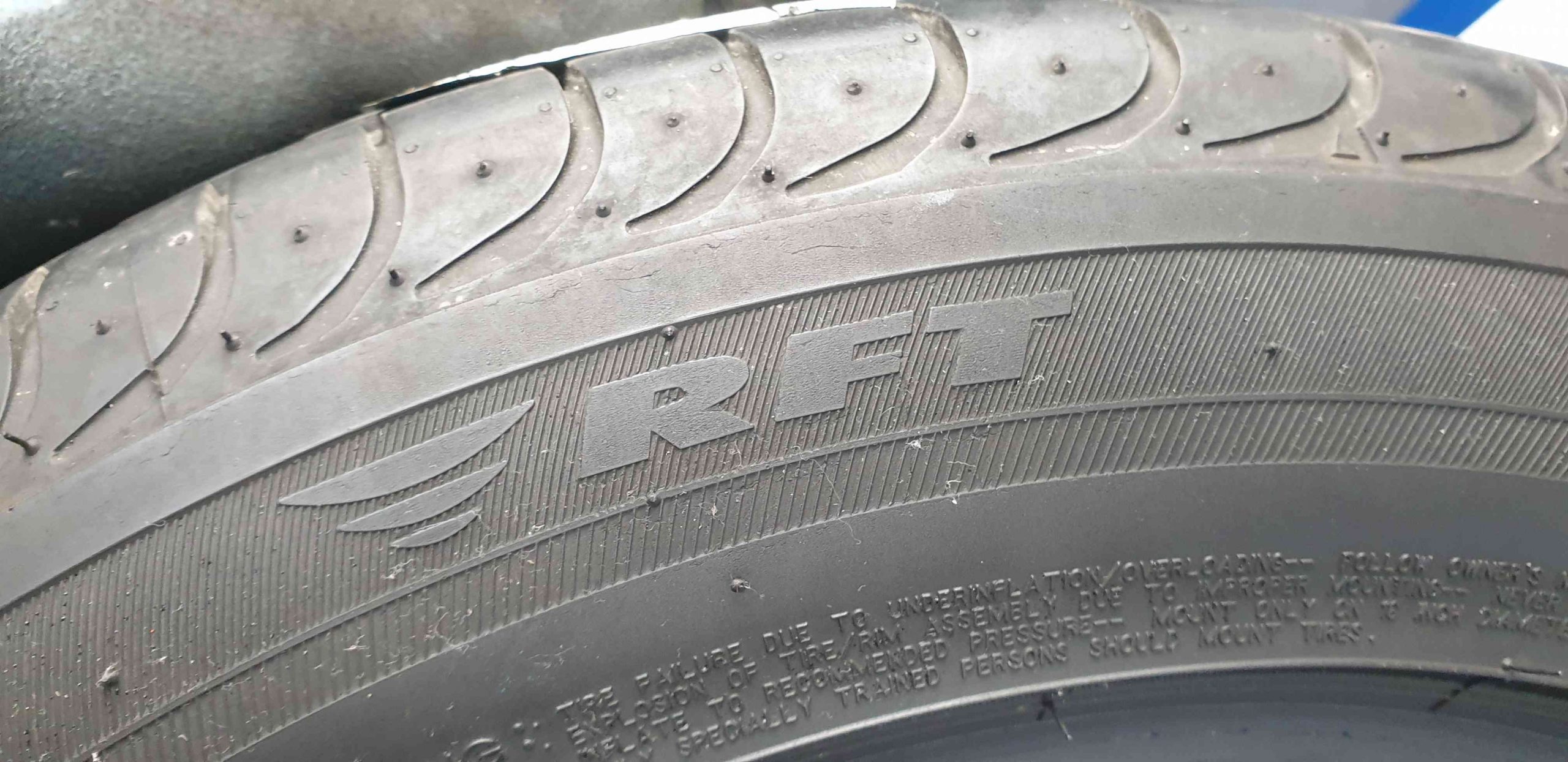
There is no single standard for the designation of puncture-resistant tires, manufacturers label them differently:
- “RunFlat” by Pirelli.
- “RFT” for Bridgestone.
- “EMT”, “DSST”, “Run On Flat” at Goodyear and Dunlop.
- “SSR” from Continental.
- “TFR” by Toyo.
- “XRP” by Kumho.
- “ZP” by Michelin.
- “ZPS” by Yokohama.
What homologation is and how it is labeled
Homologated tires are tires that have been specially modified to meet the requirements of a particular automaker. As a rule, such tires are created for premium brands and companies producing sports cars. Such “branded” copies do not differ from other tires of the same model by the tread pattern, but may have a different internal structure or composition of the rubber compound. This additionally improves the handling or comfort of the machine for which they are designed.

Tires for each brand are indicated by their icon on the sidewalls. For example, M0 – Mercedes-Benz, A0 – Audi, pictogram with a five-pointed star – BMW, N0 (N1, N2, N3) – Porsche, etc.
How to know when tires were manufactured
All tires are marked with the date of manufacture. It is indicated by four digits enclosed in an oval, and is most often located closer to the rim of the disk.
The record is deciphered as follows:
The first two digits are the serial number of the week in the year on which the tire was released.
The third and fourth digits are the year of manufacture.
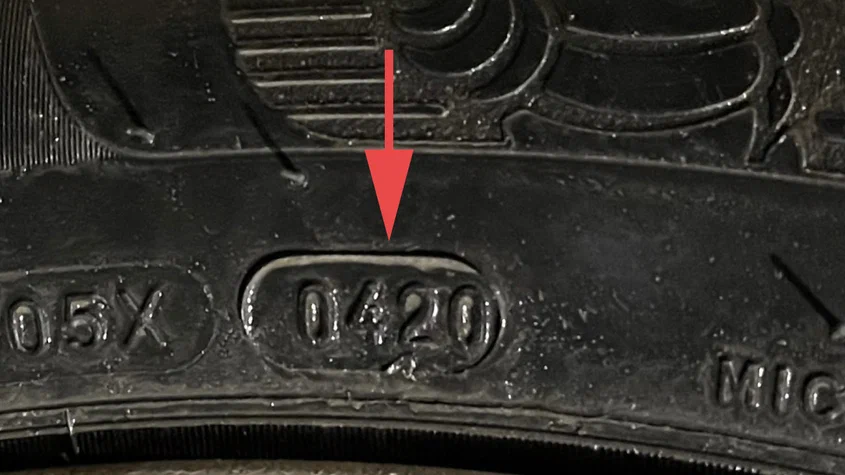
For example, the designation “0420” means that the tire was manufactured in the fourth week of 2020.
On average, tires last no more than 5 years, and for winter studded tires, until they lose about 50 percent of their studs.
Under proper maintenance conditions, tires retain their properties for about 4-5 years, and then the rubber inevitably degrades. Before buying it is worth checking the date of manufacture and refrain from buying old rubber. And when in use, remember to replace the tire that has worn out its tread with a new one – even if it still has a lot of tread.
How important it is where the tire is made
On the sidewall of any branded tire you can find the standard “Made in…” inscription. However, the country where the tire is made is not always the same as the home of its brand. On the contrary, it is more profitable for companies to localize production, locating factories closer to consumers.
For the same reason, the production of a tire in China or Russia does not mean that it is worse than the “original” tire from Europe or Japan. Factories in third countries are often even more modern, production control is just as strict, and the quality of products is at least as good.
Where to certify tires
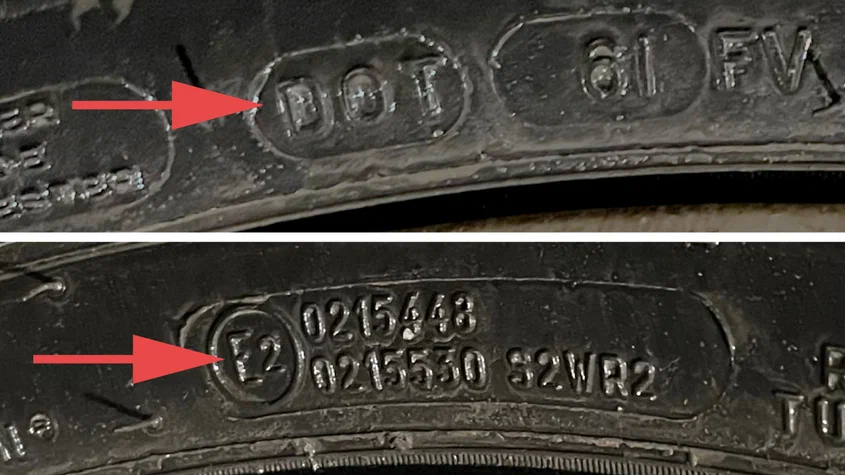
Tire – a part that directly affects safety, so any model of tire must undergo the procedure of international certification. In accordance with the Technical Regulations of the Customs Union TR TS 018/2011, each tire must have at least one of the markings: E (European certification) or DOT (certification for America). Information about the country that issued the European certificate of conformity and the number of the document itself is placed on the sidewall of the tire. The capital letter “E” with digits from 1 to 48 is the country code according to the classifier. Often on the wheel there are both markings: E and DOT.
How to Determine Tire Wear
The main indicator of wear is the remaining tread depth. According to the law, for summer rubber of a passenger car it should not be less than 1.6 mm, and for winter rubber – a minimum of 4 mm.
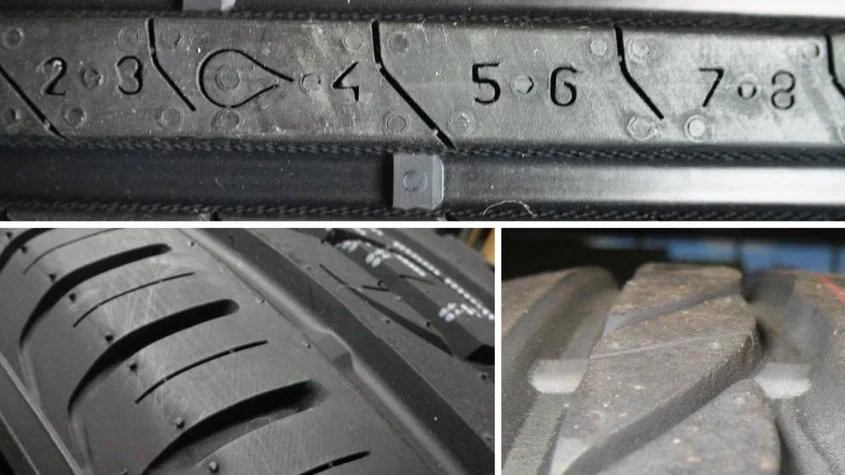
The tread can be measured with a ruler or a special digital device. But manufacturers also place different wear indicators on the tires:
Inserts in the grooves of the minimum allowable height. When the tread wears flush with the insert, the tire needs to be replaced.
Check digits or symbols on the tread beads. They are pressed out to a strictly defined depth and as the tire wears, they disappear one by one – up to the outermost one, signaling critical tread depth.
How to properly mount tires
The tire may have “rotation” (with an arrow or similar symbol) and “inside/outside” markings. These markings indicate the correct direction of wheel rotation and the inside/outside sidewall of the tire, telling tire fitters how to properly mount the tire on the rim. This is necessary for directional and asymmetrical tire models.
If the tire is installed incorrectly, the tread will not drain water and will make more noise, and traction may also suffer.
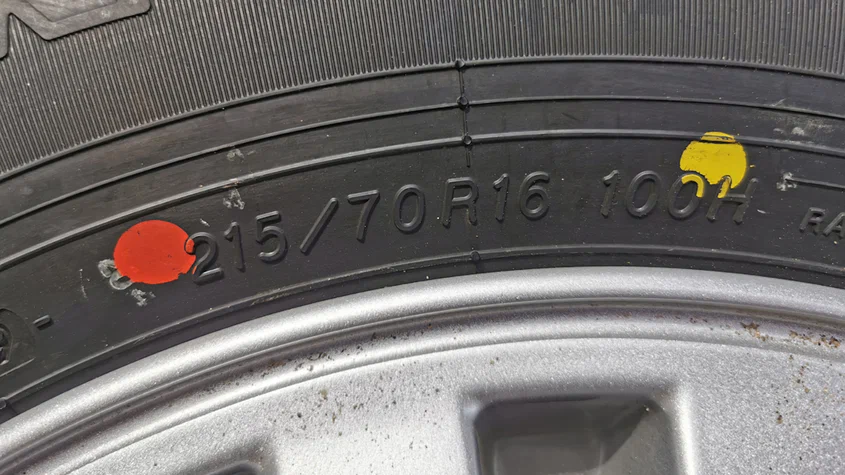
You may also see colored dots or triangles on the sidewall and tread stripes on a new tire:
- A red dot indicates the stiffest point of the sidewall.
- The white dot is placed on the most flexible point of the tire.
- The colored stripes are applied at the factory for internal purposes – they have no meaning for customers.
But the yellow dot is useful – an experienced tire fitter will assemble the wheel so that it is opposite the nipple. This will make it easier to balance the wheel.
What the sticker patterns mean
According to international requirements, a sticker must be affixed to the tread of a new tire. It indicates schematically (with arrows and Latin letters) what class the tire belongs to in terms of such parameters as fuel efficiency, noise and wet stability (water drainage).
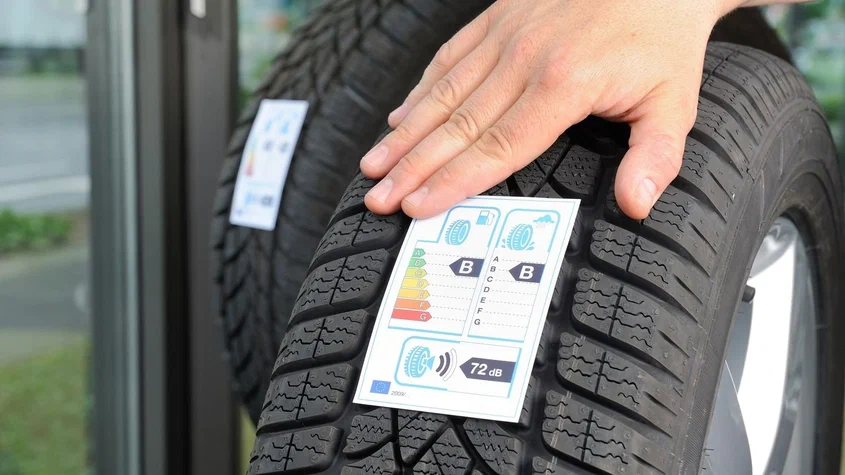
So, in brief
| Summary | Details |
|---|---|
| Rubber manufacturer and model | Specified in the largest font |
| Size | Width in mm, profile height in %, diameter in inches |
| Load and speed indices | Designated by small numbers and Latin letter |
| Additional symbols | May indicate reinforced tire construction |
| RunFlat Technology | Makes it possible to drive a certain distance safely after a puncture, labeling differs between brands |
| Homologated tires | Made specifically for certain car brands, compound optimized for specific applications |
| Rubber wear | Determined by measuring tread depth or by wear indicators |
| Asymmetrical and directional tires | Information on direction of rotation and outside/inside of the wheel, color coding indicates special points of the tire |
| Stickers on new tires | Indicate fuel efficiency, noise and drainage class |
| Certification of car tires | Marked with a special test mark on the sidewall |
0 Comments